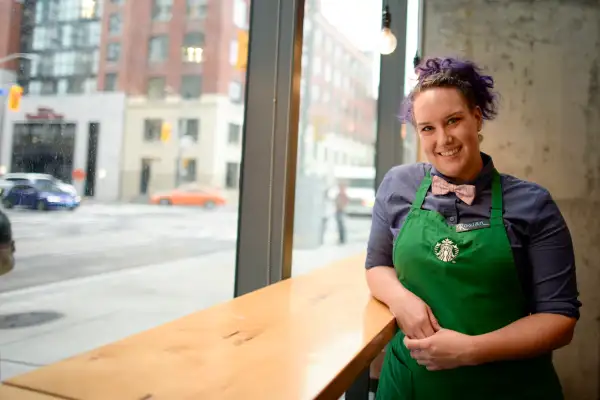Starbucks Offers a New Perk to Employees Without Having to Pay a Cent

Starbucks has traditionally forced its employees to dress in simple black, khaki or white, tightly orchestrating their color palate to match the Starbucks green and black aprons. Some people thought the company's rules were peculiar, considering that tattoos, piercings, and "self-expression" through personal aesthetics have been such classic characteristics of many other coffee shops -- so much so that the barista look has devolved into parody. And while many Starbucks employees fit the stereotype of a barista after hours, on the job they weren't allowed to.
But things are slowly changing at the famously controlling coffee giant. In 2014, tattoos and piercings come off the verboten list. And now the company has released a new dress code aiming at promoting "self-expression."
As the Washington Post's Sarah Halzack notes, relaxing the dress code is tantamount to a perk.
This is not a gift, however, but a calculated play. Though it's easy to forget, perks are a form of compensation and a way of attracting and keeping employees. The goodwill created by not having to wear a uniform—or conform to a strict dress code—is something that can help the company stand apart from competitors.
In her analysis, the Post's Halzack relayed two anecdotes in which Walmart told its employees they could wear denim (albeit black or khaki), and Best Buy told its employees they were allowed to wear comfortable shoes to better weather the Black Friday customer assault. "The applause and shouts of approval were thunderous," Halzack wrote.
The consumer-side benefits of a more relaxed dress code are less quantifiable, but not unimportant. While customers may value professionalism in a uniform—its almost-singular design purpose—a little could go a long way. For retail, anyway, the uniform's chief advantage for a shopper is knowing where to direct questions.
Starbucks' dress code document is fascinating, attempting to catalog and rate varying styles of casual clothing. Of course, the resulting taxonomy isn't purely about aesthetics -- but we finally get to see that the company knows the difference between selvedge denim vs. denim, and makes that distinction in its literature.
So what's allowed and banished?
Subtle patterns, solids, henleys, 3/4-sleeve, polos are fine. You can even wear a casquette, fedora, or a beanie.
But you won't see any employee with a neckline that plunges beneath the apron's top, or busy embroidery, t-shirts, hoodies, canvas shoes, or more than two open buttons. Apparently Starbucks drinkers aren't ready for those kind of personalities to be self-expressed.